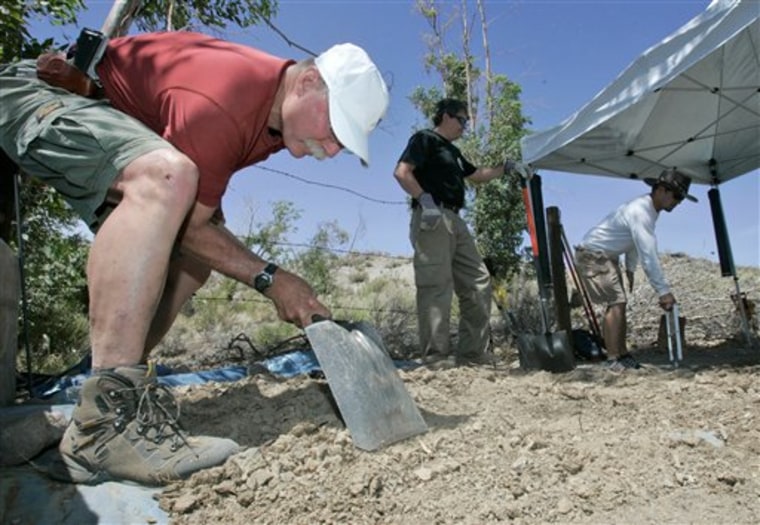Investigators and scientists went to Charles Manson's last hideout to hunt for clandestine graves that could contain other possible victims. The closest thing they found were animal bones.
The dig for human remains ended Wednesday after four sites yielded no bodies, leaving scientists puzzled over the clues that enticed them to go this far.
The excavation had been scheduled to last three days, ending Thursday. But the work went faster than scheduled, with the crew of 20 digging until dusk, then camping out at night beside the ranch house Manson and his followers had used.
"There have been no human remains found," Inyo County Sheriff Bill Lutze said. "We're finishing up this site and that'll be it for the day — nothing."
Manson and his followers hid out at Barker Ranch after their 1969 killing spree in Los Angeles. For years, rumors have swirled about other possible Manson victims, including hitchhikers and runaways who visited the site and were never heard from again.
The clan was ultimately prosecuted for nine murders; Manson is serving a life prison sentence.
Lutze said investigators were glad they didn't find evidence of any additional victims.
"If we came up with nothing, that's great because (it means) there's nobody out here buried," he said.
Shell casings and rats
Scientists who conducted a preliminary probe of the rugged, remote site in February said they identified several spots that could be graves, leading the sheriff to conduct the exploratory excavation.
By Wednesday afternoon, the four sites deemed most likely to hold human remains had been dug up and the dirt sifted. With the work done, the teams packed up and went home for good.
The search revealed little more than a .38-caliber shell casing — found on the surface on the first day and promptly dismissed by law enforcement personnel as being recent — and a pack rat's underground nest.
One site revealed fragments of animal bones, an ash pit and some stones used to make arrowheads. Rangers determined it was of archaeological interest, so digging stopped and the site was turned over to the National Park Service.
The rugged terrain, accessible only by four-wheel-drive vehicles, and triple-digit temperatures, made the work hard for those involved. The nature of the soil — dry and chocked with rocks — made it difficult to operate some of the new forensic tools being put to work on the project, some for the first time on a case outside the laboratory, researchers said.
"The story here is not what was found or what was not found but how we looked," forensic consultant Charles Illsley said. "I can tell you based on my experience that this has been one of the most exhaustive applications for a number of combined technologies."
‘Everybody loves a mystery’
The researchers said the physical environment made it harder to determine what was underground. Plants that exude unusual chemicals and rocks with magnetic properties were throwing off their equipment, they said.
"I haven't been this frustrated in a very long time," said Arpad Vass, a senior researcher at the Oak Ridge National Laboratory.
Vass said the excavation was a learning process.
"We're trying to improve the science. It's in its infancy," he said. "There could be additional people out there. But unless there are leaps in this kind of science, we'll never know."
In Ballarat, an abandoned mining town near the mouth of the canyon that leads to the ranch, Rock Novak, the town's only resident, held out the last of a series of Manson T-shirts he had made.
Few people come through the area: off-road enthusiasts, the occasional movie crew looking for a dramatic landscape, Manson fanatics. Even after the out-of-town crew leaves, Novak expects a trickle of visitors to the cult's abandoned home.
"Everybody loves a mystery," he said.
